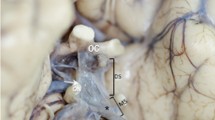Abstract
Purpose
Parietal foramina (PFs) are openings of fine canals that perforate the parietal bone. However, few studies have investigated the entire canals and their emissary vessels (EVs). Here, we explore the EVs with magnetic resonance imaging.
Methods
A total of 104 patients who underwent contrast examinations and exhibited an intact scalp, skull, dura mater, and superior sagittal sinus were enrolled in this study. Imaging data were obtained as thin-sliced, seamless sagittal sections and were transferred to a workstation for analysis.
Results
A total of 116 EVs passing through the PF and inner canals (parietal canal) were identified in 78 patients (75 %). All the EVs were found to perforate each layer of the parietal bone. Of 104 patients, 68 % exhibited one EV, 30 % two EVs, and 2 % three EVs. In 85.3 %, the EV was entirely delineated in one sagittal slice, 10.3 % were covered by two slices, and 4.3 % by three slices. In 68 %, the EV connected to the upper surface of the superior sagittal sinus (SSS) with variable courses from near-vertical to horizontal inclinations.
Conclusions
EVs perforate the skull with variable inclinations, while showing a highly consistent course in the sagittal dimension. The PF and EV can be used as landmarks of the SSS lying immediately below.





Similar content being viewed by others
References
Akabori E (1933) Crania nipponica recentia. Analytical inquiries into the non-metric variations in the Japanese skull. Jpn J Med Sci I Anat 4:61–318
Billy G (1955) Recherches sur les trous pariétaux. Bull Mém Soc Anthropol Paris 6:147–158
Cave AJE (1928) Two cases of congenitally enlarged parietal foramina. J Anat 63:172–174
Chapot R, Saint-Maurice JP, Narata AP, Rogopoulos A, Moreau JJ, Houdart E, Maubon A (2007) Transcranial puncture through the parietal and mastoid foramina for the treatment of dural fistulas. Report of four cases. J Neurosurg 106:912–915
Currarino G (1976) Normal variants and congenital anomalies in the region of the obelion. AJR Am J Roentgenol 127:487–494
Fein JM, Brinker RA (1972) Evolution and significance of giant parietal foramina. Report of five cases in one family. J Neurosurg 37:487–492
Little BB, Knoll KA, Klein VR, Heller KB (1990) Hereditary cranium bifidum and symmetric parietal foramina are the same entity. Am J Med Genet 35:453–458
Mupparapu M, Binder RE, Duarte F (2006) Hereditary cranium bifidum persisting as enlarged parietal foramina (Catlin marks) on cephalometric radiographs. Am J Orthod Dentofacial Orthop 129:825–828
Panteado CV, Santo Neto H (1985) The number and location of the parietal foramen in human skulls. Anat Anz 158:39–41
Reddy AT, Hedlund GL, Percy AK (2000) Enlarged parietal foramina: association with cerebral venous and cortical anomalies. Neurology 54:1175–1178
Yoshioka N, Rhoton AL Jr, Abe H (2006) Scalp to meningeal arterial anastomosis in the parietal foramen. Neurosurgery 58(1 Suppl):ONS123–ONS126
Acknowledgments
This work did not receive any grant. We thank Professor AL Rhoton Jr for supporting the cadaveric study in the present work performed at the Department of Neurological Surgery, University of Florida, Gainesville, FL, USA.
Author information
Authors and Affiliations
Corresponding author
Ethics declarations
Conflict of interest
The authors have no conflict of interest concerning the materials or methods in this study or the findings specified in this paper.
Rights and permissions
About this article
Cite this article
Tsutsumi, S., Nonaka, S., Ono, H. et al. The extracranial to intracranial anastomotic channel through the parietal foramen: delineation with magnetic resonance imaging. Surg Radiol Anat 38, 455–459 (2016). https://doi.org/10.1007/s00276-015-1579-4
Received:
Accepted:
Published:
Issue Date:
DOI: https://doi.org/10.1007/s00276-015-1579-4




